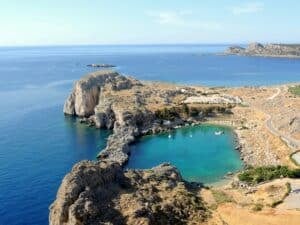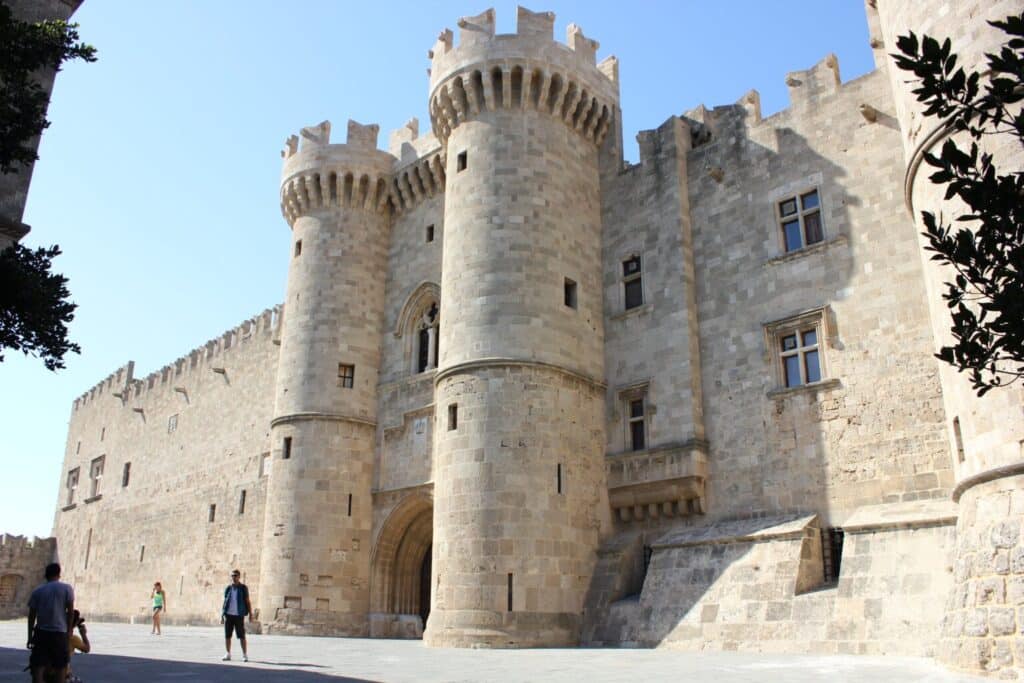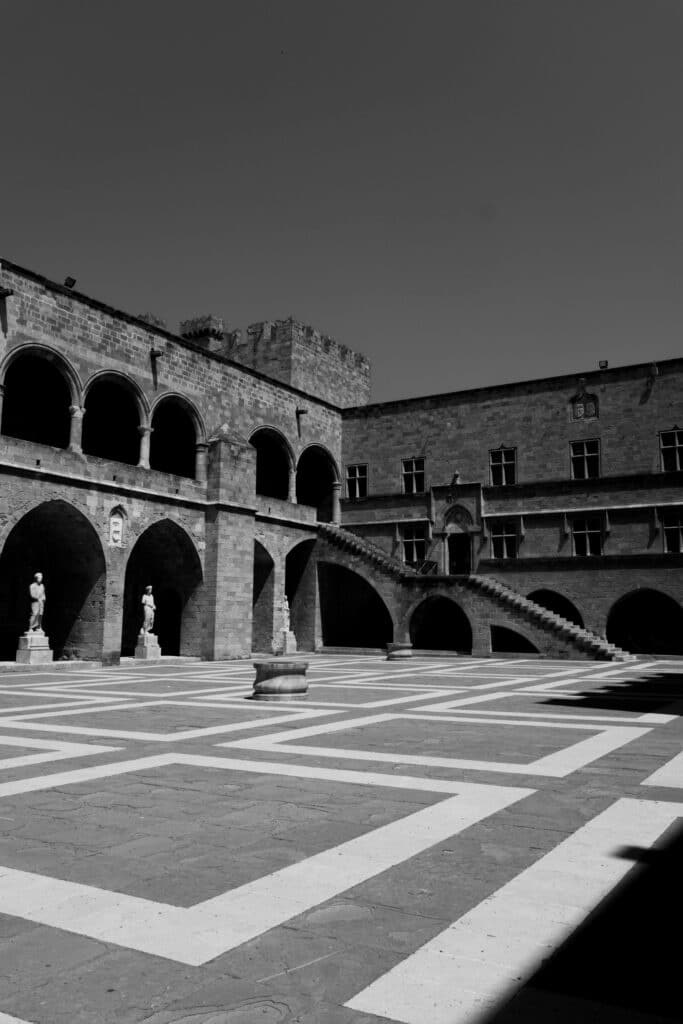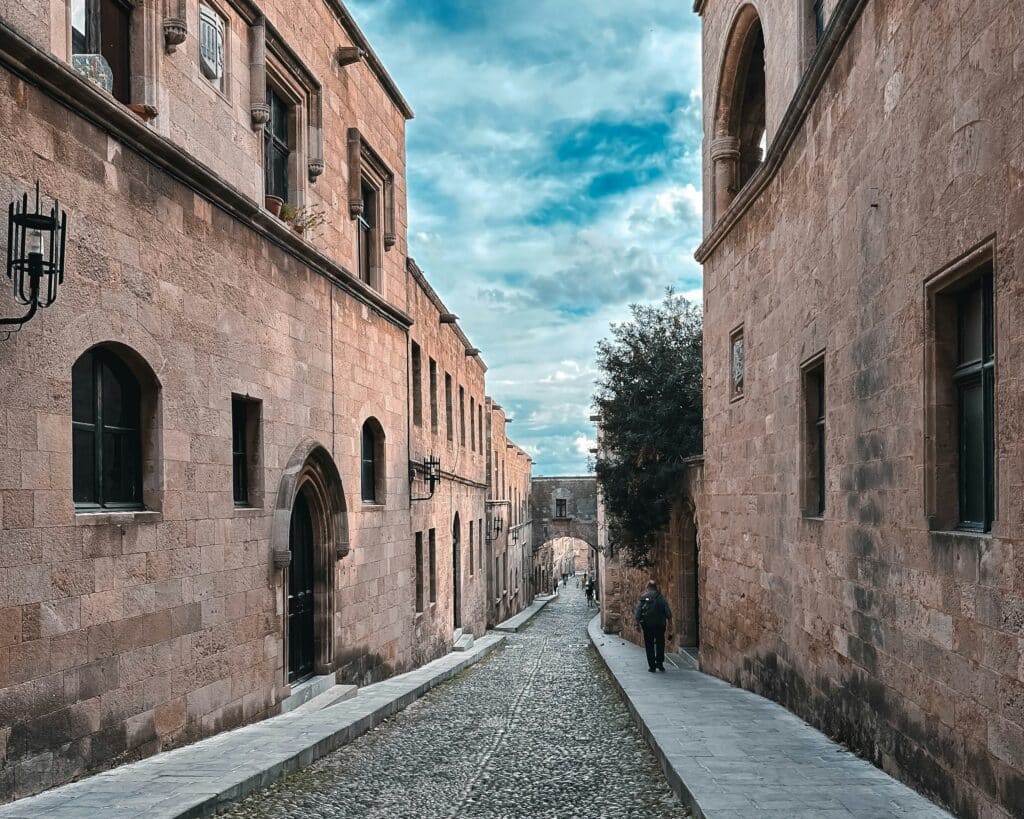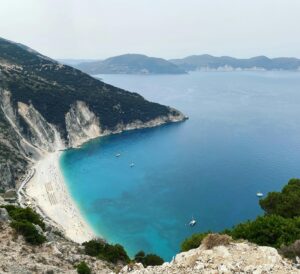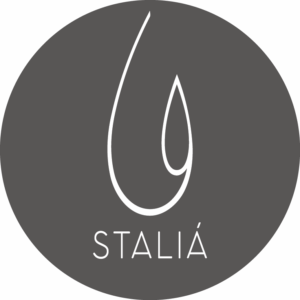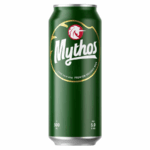The Origins of the Palais des Grands Maîtres: The Foundation of a Medieval Monument
The Palace of the Grand Masters was built in the 14th century by the Knights of St. John, who took control of Rhodes after their victory over the Saracens. The palace served not only as the residence of the order’s Grand Masters, but also as a fortress, administrative headquarters and military command center.
The initial construction of the palace
Construction of the palace began in 1309, after the Knights of St. John acquired the island of Rhodes. The project was both defensive and symbolic: to create a strong residence that would reflect the Order’s power while protecting the island’s strategic interests. Rhodes, located at the crossroads between the West and the East, was an ideal strategic position for the Knights.
The palace was designed to withstand attack and serve as a logistical base in the event of siege. As such, it was built with massive surrounding walls, towers and defensive ditches. The Knights used local materials, notably the island’s limestone, to erect this imposing monument.
The Role of the Knights of St. John in Conception
The Knights of St. John, originally from Jerusalem and the Mediterranean islands, played a key role in the palace’s design. They called on Italian architects and local craftsmen to create a structure blending medieval architecture with Gothic and Romanesque elements. This blend gave the palace a utilitarian yet majestic appearance, with solid foundations to withstand attack while providing sumptuous living spaces for the grand masters.
The First Functions of the Palace
Since its construction, the palace has played an essential role for the Order of the Knights of St. John. It was an administrative, military and religious center. The Knights held strategic meetings, religious ceremonies and diplomatic events here. The palace was also a symbol of Christian power in the eastern Mediterranean.
Over the years, the palace has been enlarged and embellished to meet the Knights’ growing needs, but its origins as a defensive fortress remain central to its identity.
Extensions to the Palais des Grands Maîtres: Evolution of a Monument through the Centuries
Over the centuries, the Palace of the Grand Masters has undergone several extensions and modifications, reflecting the changing needs of its occupants and the evolving historical context of the island of Rhodes.
Changes under Ottoman domination
After the fall of the Knights of St. John and the capture of Rhodes by the Ottoman Empire in 1522, the palace underwent several transformations. The Ottomans first used it as an imperial residence. Many elements of the Christian architecture were modified to incorporate Ottoman influences. For example, some annex buildings were added to meet the Empire’s administrative needs, and structures such as minarets were installed within the palace walls.
Ottoman modifications also added new decorations, in particular mosaics and architectural elements specific to the Empire, while retaining the palace’s medieval skeleton. These adaptations enabled the palace to maintain its role as a center of power, while reflecting the rise of the Ottoman Empire in the region.
20th Century Restorations: A New Life for the Palace
In the early 20th century, after the Ottomans withdrew and Rhodes became part of Greece, efforts were made to restore the Palace of the Grand Masters. The Greek authorities, with the help of European experts, undertook extensive restoration work to preserve the building’s integrity while restoring it to its former glory.
In 1912, after the Italian occupation of Rhodes, Italy launched a restoration program to restore the palace to its original appearance, making it a symbol of Mediterranean history. Medieval architecture and Ottoman additions were carefully restored to maintain historical coherence.
The Palace as Museum: Its Evolving Role
After restoration in the 1920s and 1930s, the palace was transformed into a museum, a function it continues to fulfil today. The transformation into a museum has made it possible to preserve the island’s cultural and historical heritage while making it available to the public. The museum houses a rich collection of artifacts from the time of the Knights of St. John, as well as objects from Greek, Roman and Byzantine antiquity. These extensions have helped to make the Palais des Grands Maîtres not only a symbol of the past, but also a living place of historical memory.
The Palace of the Grand Masters: A Living Museum of the History of Rhodes
The Palace of the Grand Masters, now a museum, plays a key role in preserving the history of Rhodes. This section explores its transformation into a museum, its collections and its current cultural impact.
A valuable historical collection
The Palace houses an exceptional collection, including objects from the Knights of St. John, Greco-Roman antiquity and other periods. Major pieces include ancient sculptures, mosaics and ceramics. These artifacts show the evolution of Rhodes, from the ancient Greeks to the Ottomans, via the Roman Empire and medieval times. Each piece reveals a unique aspect of the island’s history.
A Heritage Conservation Site
The museum plays an important role in preserving our historical heritage. It protects rare manuscripts, ancient documents and other fragile objects. These archives enable us to trace the history of Rhodes and the cultural exchanges that have marked the island over the centuries. In this way, the museum ensures not only the preservation of artifacts, but also the transmission of knowledge to future generations.
Temporary Exhibitions and Cultural Events
The Palais des Grands Maîtres also organizes temporary exhibitions and cultural events, enriching the visitor experience. Concerts, lectures and educational activities are regularly scheduled, offering immersion in local culture. These events allow visitors to discover new aspects of the island’s history and heritage.
Tourist and Economic Impact of Museification
The museum attracts thousands of visitors every year, contributing to the local economy. The Palace of the Grand Masters is a major asset for tourism in Rhodes. It showcases the island’s cultural heritage while raising public awareness of its history. The museum also supports local initiatives and promotes cultural development on an international scale.
Palace architecture: a blend of medieval and Byzantine styles
The architecture of the Palace of the Grand Masters is distinguished by its blend of medieval and Byzantine styles. This masterpiece offers a unique fusion of defensive functionalities and decorative elements, providing an in-depth understanding of the period.
Imposing fortress with towers and defensive walls
The palace is typical of medieval fortresses. Its thick walls and solid towers recall its defensive role during the Crusades. The fortress was designed to resist attack while serving as a residence. The imposing, military aspect is underlined by the height of the towers, offering strategic views over the island.
Byzantine influence on design
Byzantine architecture strongly influences the Palace’s design. The use of mosaics and frescoes in the interiors reflects this inspiration. The vaults and arches are typical elements of the Byzantine style. Both exterior and interior decorations incorporate religious motifs, symbolizing the prosperity of the Byzantine Empire at the time.
Building Materials and Techniques
The materials used to build the palace came mainly from the surrounding islands, such as marble and local stone. Marble is omnipresent in the structure, and advanced construction techniques of the time were employed. Craftsmen designed solid, decorative walls, combining aesthetics and durability. These techniques have enabled the building to survive many centuries of history.
Comparison with other medieval palaces in Europe
The Palais des Grands Maîtres shares many similarities with other medieval palaces in Europe. Like the Palais des Papes in Avignon or the Château de Vincennes in Paris, it combines defensive and residential elements. However, the integration of Byzantine influences in the Palais de Rhodes makes it particularly unique compared to other European medieval buildings. The layout of the towers and gardens is also reminiscent of some other medieval palaces, but with its own distinctive features specific to the island’s architecture.
The Palace's Artistic Treasures: Sculptures, Mosaics and Decorations
The Palace of the Grand Masters is packed with artistic treasures, from ancient sculptures to Byzantine mosaics. These works illustrate not only the cultural wealth of the period, but also the historical influence of the Knights of St. John.
Byzantine mosaics and antique sculptures
Byzantine mosaics adorn several rooms in the Palace. They depict religious scenes and geometric motifs, typical of Byzantine art. These mosaics use brilliant materials such as colored stones and gold, creating vibrant images that captivate the eye. Ancient sculptures are also present, including busts of historical figures and statues representing Greek gods. These pieces testify to the grandeur of the Roman Empire and the influence of Antiquity on medieval culture.
The Hall of the Nine Muses: A Unique Artistic Treasure
The Hall of the Nine Muses, located in the heart of the Palace of the Grand Masters, is one of the most impressive. This room features colorful mosaics representing the nine Muses, the Greek goddesses who inspired the arts and sciences. Each Muse is associated with a particular field:
- Calliope, epic poetry,
- Clio, the story,
- Erato, lyric poetry,
- Euterpe, music,
- Melpomène, the tragedy,
- Polyhymnia, sacred poetry,
- Terpsichore, the dance,
- Thalie, the comedy,
- Uranie, astronomy.
The scenes depicted in this room reflect the Knights of St. John’s admiration for ancient Greek culture and mythology. The fine details, particularly in the mosaics adorning the floor and walls, highlight the importance of art to these knights, both as wielders of power and protectors of classical culture.
The mosaics in the Salle des Neuf Muses are made from precious materials such as gold tesserae and semi-precious stones, creating an atmosphere of elegance and splendor. These works illustrate the ideal of beauty and knowledge of ancient civilizations, which the Knights sought to preserve and celebrate in their Palace.
The Animal and Mythological Mosaics of the Palace
The Palace of the Grand Masters is home to a number of fascinating mosaics telling stories of wildlife and mythology. These works testify to the cultural exchanges between Rhodes and other ancient civilizations, such as Egypt and the Orient, and illustrate the admiration of the Knights of St. John for ancient cultures and traditions.
This mosaic, located in the peristyle of the Palace, depicts emblematic animals of the Nile, such as crocodiles, hippopotamuses and exotic birds. It reflects the commercial and cultural links between Rhodes and ancient Egypt.
- The Winged Child and the Fawn Mosaic
An intriguing mosaic depicting a winged child riding a fawn, inspired by Dionysus’ mythological travels in India. It symbolizes the fusion of Greek and Eastern influences, highlighting the cultural richness of the Palais.
This mosaic depicts a lion-hunting scene, symbolizing the bravery and skill of ancient hunters. It also highlights the importance of hunting in ancient Mediterranean culture, while underlining the skill of the craftsmen of the time.
The Story Behind Some Famous Pieces
Some of the works in the Palace have a fascinating history. For example, mosaics depicting scenes from Greek mythology allude to the ancient history of Rhodes and its inhabitants. A statue of Zeus, found in antiquity, is one of the most emblematic pieces. It reflects not only the grandeur of Greek civilization, but also the admiration of the Knights of St. John for ancient art. These sculptures and objects tell the story of the island through the ages.
Objects and sculptures bear witness to the history of Rhodes and the Knights.
The objects in the Palace tell the story of Rhodes and the Knights of St. John. For example, a number of weapons and suits of armor dating from the time of the Crusades are on display, illustrating the military challenges faced by the Knights. Decorative objects, such as furniture and tapestries, bear witness to the Knights’ way of life, between luxury and utility. In this way, every work and every object in the Palace contributes to a better understanding of Rhodes’ role in this period, and of its strategic and religious importance.
The Spaces of the Palace: A Visit Through Rooms and Gardens
The Palace of the Grand Masters offers a variety of impressive rooms and magnificent gardens. Each room invites you to explore the history of Rhodes and its rulers.
The main halls of the Palais
The Palace is home to several remarkable rooms. The throne room, for example, is of majestic grandeur. It was used for important ceremonies and royal audiences. The Grand Masters’ chambers are equally impressive, decorated with antique furniture and works of art. Each room tells its own story, marked by the passage of the Knights of St. John and the wealth of the medieval era.
La Salle Laocoön: a tribute to ancient art
Among the most fascinating rooms, the Laocoön Room stands out for its link with ancient art. It pays tribute to the Rhodian sculptors who created the famous statue of Laocoön, depicting the ancient hero battling snakes. This work symbolizes the heritage of classical Greek art, a major element in the knights’ culture. The room illustrates the Knights of St. John’s admiration for ancient Greek art, a tribute to their vision of beauty and the chivalric ideal.
La Salle des Chevaliers
The Salle des Chevaliers is a large historic room where knights used to gather for ceremonies, feasts and important gatherings. It is decorated with magnificent frescoes and tapestries depicting scenes from the lives of the knights, including their military exploits. The ornate ceiling and large windows create an imposing atmosphere that testifies to the power and authority of the Knights of St. John.
The Armament Room
The Salle de l’Armement is dedicated to the display of armor and weapons used by knights. You’ll discover swords, shields, axes and armor dating back to medieval times and the Crusades. The layout of the room shows how knights prepared for battle. Sculptures and replicas of armor add to the authenticity of the place, offering visitors a detailed view of the equipment used by the defenders of Rhodes.
The Card Room
The Map Room is another fascinating room where visitors can discover historical maps showing the evolution of Rhodes and the Mediterranean over the centuries. It offers an insight into the maritime explorations and military strategies that have shaped the island’s history. These ancient maps are accompanied by explanations of Rhodes’ strategic role and its importance during the Crusades.
The Importance of Gardens and Exterior Architecture
The Palace gardens are equally fascinating. Their layout, combining green spaces and fountains, reflects the influence of Byzantine and medieval architecture. The interior gardens are perfect for a leisurely stroll, offering soothing views of the sea and the city. The exterior architecture, meanwhile, features fortified elements, with large towers and imposing walls that recall the palace’s defensive function.
How to visit the Palace of the Grand Masters: Practical Information
Opening hours
Open daily from 8 am to 8 pm from April 1 to October 31.
Last admission at 7:30 pm.
Open daily from 8:30 a.m. to 3:30 p.m. from November 1 to March 31 (closed Tuesdays).
Last admission at 3:00 p.m.
Visit price
10 (includes the Archaeological Museum, the Panagia tou Kastrou church and the Decorative Arts Collection).
Free visit
-
Children and young people up to the age of 25
from EU member states, on presentation of ID card or passport.
-
Children up to 5 years
(non-EU countries), on presentation of passport.
-
Persons over 25 years of age
in secondary education (including night schools) from EU member states and EEA countries, on presentation of certificate of attendance.
Visiting time
Between 90 minutes and 2 hours to explore the Palace of the Grand Masters of the Knights of Rhodes.
Free admission dates
-
March 6th
In memory of Melina Mercouri.
-
June 5th
International Environment Day.
-
April 18th
International Monuments Day.
-
May 18th
International Museum Day.
- Last weekend in September: European Heritage Days.
-
First Sunday of each month
between November 1 and March 31.
-
National holidays
(March 25 and October 28).
Accessibility
Courtyard and exhibition accessible to the disabled, as well as the “Rhodes, 2,400 years” exhibition.
Accessible to people with reduced mobility by elevator.
Accessible for the disabled.
Tips for Avoiding Strides and Enjoying a Quiet Visit
For a quieter experience, plan your visit for early morning or late afternoon, when there are fewer crowds. Try to plan your visit during the week too. If you choose a guided tour, you’ll be able to explore more serenely, as the guides can take you to less crowded areas of the palace.
Guided Tour: A Complete Experience
A guided tour provides a better understanding of the history and architecture of the Palace of the Grand Masters. Local guides share interesting anecdotes and details about different parts of the building, including sculptures, frescoes and stories of the knights. Book in advance to enjoy an in-depth experience without too much delay.
Tips for an Optimal Visit
Take your time to explore every room in the palace. The throne room, knights’ chambers and gardens are particularly impressive. Visit in the morning to avoid the crowds and enjoy a more serene atmosphere. Bring water, especially in summer, as the tour can last several hours. Don’t forget to use an app or guide to enrich your understanding of the history and architecture.
Best times to visit
Spring (April to June) and autumn (September to October) are the best times to visit the palace. You’ll find pleasant temperatures and fewer tourists. If you’re visiting in summer, you’ll want to choose a quieter time of day, early in the morning or late in the day.
Fascinating facts and anecdotes about the Palace of the Grand Masters
The Palace of the Grand Masters is a place rich in history and mystery. From its medieval roots to its role during the Turkish occupation, every corner of this monument reveals a part of Rhodes’ history. Here are a few fascinating anecdotes that contribute to the palace’s legendary aura:
The Palace as Prison during the Turkish Occupation
During the Ottoman occupation after 1522, the Palace of the Grand Masters was used as a prison. After the fall of the Knights of St. John, the Turkish authorities transformed the palace into a detention center. This military role marked the palace’s history before it became a royal residence in the 20th century.
The earthquake of 1856
A devastating earthquake in 1856 damaged the Palace of the Grand Masters. This catastrophe caused extensive damage to the structure, and led to restoration work. The building still retains traces of the earthquake, adding to its historic character.
The Byzantine Foundation and Discovery under the Palace
The Palace of the Grand Masters rests on a Byzantine foundation, bearing witness to Rhodes’ ancient history long before the arrival of the Knights of St. John. During archaeological excavations linked to restoration work, a Byzantine church was discovered beneath the Palace. This discovery brought to light architectural and cultural remains dating back to the Byzantine era, even before the construction of the medieval Palace.
These ancient elements are still visible today, blending harmoniously with the Palace’s Gothic and medieval architecture to create a veritable architectural palimpsest. The discovery of the Byzantine church and other structures testifies to the historical importance of the island, adding a fascinating dimension to the history of the Palace of the Grand Masters.
Restoration by Fascist Italy
During the Italian occupation of Rhodes (1912-1948), Italy undertook restoration work to transform the Palace into a museum. The Fascist authorities used specific construction techniques and incorporated elements of Italian architecture, while preserving certain medieval aspects. This period profoundly altered the Palace and its appearance.
The Palais as a venue for international exhibitions
The Palazzo dei Grandi has hosted several international exhibitions, including the one in 1934. This exhibition marked the completion of the restoration work undertaken by the Italian authorities, drawing the attention of visitors from all over the world to this majestic monument.
The Grand Master's Secret Routes
Beneath the grandeur of the Palace lies a complex network of secret passages and underground tunnels. These routes were designed to enable the Grand Master and knights to escape silently during sieges, or to move troops discreetly. These passages add a mysterious dimension to the Palace, recalling the military tactics of the time.
The Ghostly Residents
Ghost stories haunt the corridors of the Palace. Visitors often speak of strange noises and ghostly figures. These stories are often linked to the tragic siege of 1522, when thousands of lives were lost defending Rhodes. Could the spirits of the fallen knights still be present in this historic place?
A room for every mood
The Palais houses unique themed rooms, such as the Salle de la Méduse and the Salle du Tigre. These spaces reflect the creativity of the designers, blending medieval and classical influences. Each room evokes ancient myths or tales of knights, creating a special atmosphere.
Mystical links with the Knights of St. John
The Palace of the Grand Masters has long been associated with the magic and secret rituals of the Knights of St. John. These knights were renowned for their mystical practices, and the palace, with its many nooks and crannies, is at the heart of several legends. Decorative elements were often chosen for their esoteric significance, adding a veil of mystery to this iconic building.
The Mystery of St Catherine's Chapel
Some believe that the Chapelle Sainte-Catherine, hidden within the Palace, houses sacred relics or ancient treasures. Although its true use remains unclear, it is possible that it served as a private place of worship or secret room for esoteric rituals conducted by the knights.
Italian Governor's Office Transformed into Tourist Site
During the Italian occupation, the Palace of the Grand Masters was transformed into the lavish office of Cesare Maria De Vecchi, the local Fascist governor. Today, visitors can discover this page of history with period furniture, a strange fusion of medieval times and modern politics.
The Symbolic Coat of Arms
The walls of the Palace are decorated with coats of arms representing the Grand Masters and Languages of the Order. Closer inspection reveals symbols and messages hidden in the carvings, telling unique stories engraved in stone.
